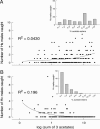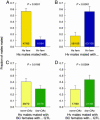Experimental evidence for interspecific directional selection on moth pheromone communication
- PMID: 16585529
- PMCID: PMC1458663
- DOI: 10.1073/pnas.0508609103
Experimental evidence for interspecific directional selection on moth pheromone communication
Abstract
The chemical composition of the sexual communication signals of female moths is thought to be under strong stabilizing selection, because females that produce atypical pheromone blends suffer lower success in finding mates. This intraspecific selection pressure cannot explain the high diversity of moth pheromone blends found in nature. We conducted experiments to determine whether communication interference from males of closely related species could exert strong enough directional selection to cause evolution of these signals. Attraction and mating success of Heliothis subflexa (Hs) females with a normal quantitative trait locus for production of acetate pheromone components (norm-OAc) were compared with Hs females with an introgressed quantitative trait locus from Heliothis virescens (Hv) that dramatically decreased the amount of acetate esters in their pheromone glands (low-OAc). In field experiments with natural Hv and Hs populations, 10 times more Hv males were captured in traps baited with live low-OAc Hs females than in traps with norm-OAc Hs females. This pattern was confirmed in mate-choice assays in cages. Hybrids resulting from Hv-Hs matings have effectively zero fitness in the field. Combining our results with the extensive data set gathered in the past 40 years on the reproductive biology of Hv, we can quantitatively estimate that the directional selection exerted by Hv males on Hs females to produce relatively high amounts (>5%) of acetates can range from 0.135 to 0.231. Such intense interspecific selection may counteract intraspecific stabilizing selection that impedes evolutionary changes in pheromone blends and could lead to diversification of sexual signals.
Conflict of interest statement
Conflict of interest statement: No conflicts declared.
Figures




Similar articles
-
Introgressing pheromone QTL between species: towards an evolutionary understanding of differentiation in sexual communication.J Chem Ecol. 2004 Dec;30(12):2495-514. doi: 10.1007/s10886-004-7946-y. J Chem Ecol. 2004. PMID: 15724967
-
Phenotypic plasticity in sexual communication signal of a noctuid moth.J Evol Biol. 2010 Dec;23(12):2731-8. doi: 10.1111/j.1420-9101.2010.02124.x. J Evol Biol. 2010. PMID: 21121086
-
Lipases and carboxylesterases affect moth sex pheromone compounds involved in interspecific mate recognition.Nat Commun. 2023 Nov 18;14(1):7505. doi: 10.1038/s41467-023-43100-w. Nat Commun. 2023. PMID: 37980401 Free PMC article.
-
Utilization of pheromones in the population management of moth pests.Environ Health Perspect. 1976 Apr;14:133-44. doi: 10.1289/ehp.14-1475097. Environ Health Perspect. 1976. PMID: 789060 Free PMC article. Review.
-
The Genetic Basis of Pheromone Evolution in Moths.Annu Rev Entomol. 2016;61:99-117. doi: 10.1146/annurev-ento-010715-023638. Epub 2015 Nov 4. Annu Rev Entomol. 2016. PMID: 26565898 Review.
Cited by
-
Disposable Polydimethylsiloxane (PDMS)-Coated Fused Silica Optical Fibers for Sampling Pheromones of Moths.PLoS One. 2016 Aug 17;11(8):e0161138. doi: 10.1371/journal.pone.0161138. eCollection 2016. PLoS One. 2016. PMID: 27533064 Free PMC article.
-
Ecological immunology: do sexual attraction and immunity trade-off through a desaturase?Insect Sci. 2025 Feb;32(1):290-300. doi: 10.1111/1744-7917.13379. Epub 2024 May 20. Insect Sci. 2025. PMID: 38769890 Free PMC article.
-
The paradox behind the pattern of rapid adaptive radiation: how can the speciation process sustain itself through an early burst?Annu Rev Ecol Evol Syst. 2019 Nov;50(1):569-593. doi: 10.1146/annurev-ecolsys-110617-062443. Epub 2019 Oct 1. Annu Rev Ecol Evol Syst. 2019. PMID: 36237480 Free PMC article.
-
Differential attraction of Heliothis subflexa males to synthetic pheromone lures in Eastern US and Western Mexico.J Chem Ecol. 2007 Feb;33(2):353-68. doi: 10.1007/s10886-006-9233-6. Epub 2007 Jan 3. J Chem Ecol. 2007. PMID: 17200888
-
Patterns of genetic and reproductive traits differentiation in Mainland vs. Corsican populations of bumblebees.PLoS One. 2013 Jun 6;8(6):e65642. doi: 10.1371/journal.pone.0065642. Print 2013. PLoS One. 2013. PMID: 23755263 Free PMC article.
References
-
- Ryan M. J., Wilczynski W. Science. 1988;240:1786–1788. - PubMed
-
- Gerhardt H. C. Anim. Behav. 1991;42:615–635.
-
- Wollerman L. Anim. Behav. 1998;55:1619–1630. - PubMed
-
- Ryan M. J., Rand A. S. Evolution. 2003;57:2608–2618. - PubMed
-
- von Helverson O., von Helverson D. In: Neural Basis of Behavioural Adaptation. Schildberger K., Elsner N., editors. Stuttgart, Germany: Fisher; 1994. pp. 253–284.
Publication types
MeSH terms
Substances
LinkOut - more resources
Full Text Sources
Other Literature Sources
Miscellaneous

